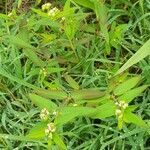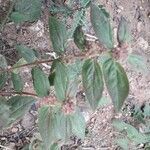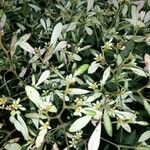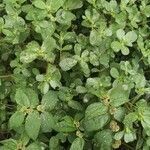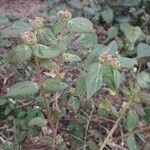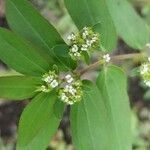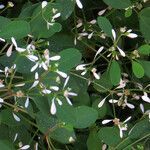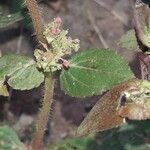Herbs, annual, 15-30 cm tall. Root fibrous, 2-3.5 mm thick. Stems branched mainly from upper parts, erect, 1-3 mm thick, glabrous or sparsely pilose. Leaves opposite; stipules triangular, 1.3-1.5 mm, free or connate; petiole 1-2 mm; leaf blade narrowly oblong or obovate, 1-2.5 cm × 4-8 mm, adaxially dark green, light green abaxially, sometimes purple-red, sparsely pilose on both surfaces, or glabrescent abaxially, base rounded, margin entire or finely serrulate toward apex, apex obtuse or rounded; involucral leaves 2, similar to normal leaves. Cyathia many in axillary or terminal cymes, peduncle 3-5 mm; involucre turbinate, ca. 1 × 1 mm, marginal lobes 5, ovate-triangular; glands 4, appendages white or light pink. Male flowers numerous, slightly exserted from involucre. Female flower: pedicel longer than involucre; ovary 3-angular, glabrous; styles free; stigma slightly 2-lobed. Capsule 3-angular, 1-1.5 × ca. 2 mm, smooth, glabrous. Seeds ovoid-angulate, ca. 1.2 × 0.8 mm, each side with several striae; caruncle absent. Fl. and fr. Aug-Dec. 2n = 32*.
Annual or perennial herb, up to 400 mm tall. Leaf margin serrate, at least in upper third. Cyathia in almost leafless lateral and terminal glomerules. Capsule glabrous, shorter than 1.4 mm. Flowers reddish brown.
A herb. It grows each year from seed. It grows 15-30 cm tall. The leaves are narrowly oblong and 1-2.5 cm long by 4-8 mm wide. They are light green underneath.
